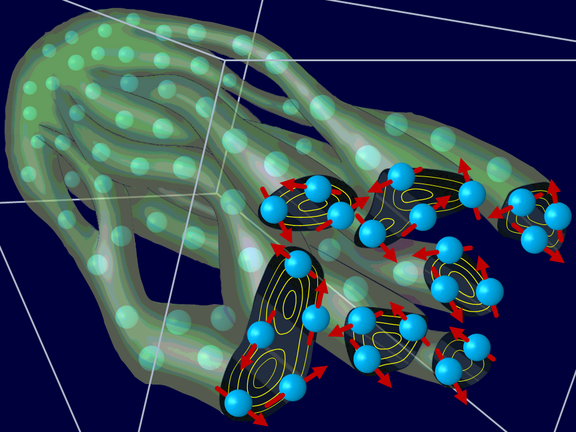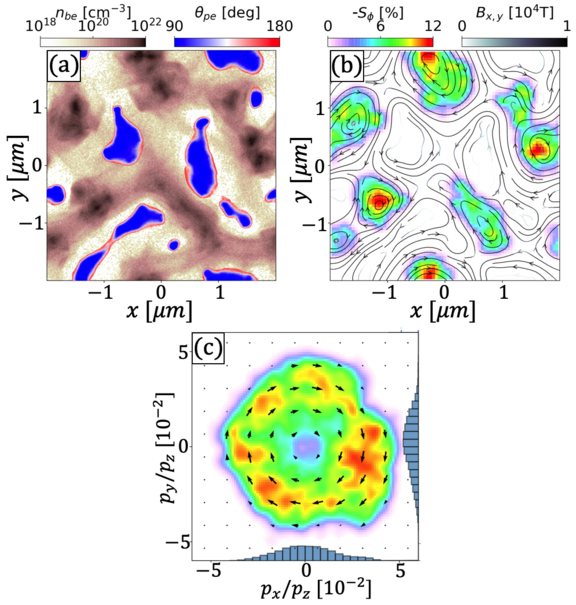Current filamentation instability (CFI), a phenomenon of a plasma beam breaking up into multiple current filaments, occurs in a counterstreaming flow or an electron beam propagating in a background plasma. CFI arises due to non-uniformities in the current transverse profile, which lead to the generation of transverse magnetic fields. The resulting Lorentz force amplifies the non-uniformity of the current and drives the instability.
CFI is important in governing various plasma phenomena spanning a large range of spatial temporal scales. Microscopically, CFI modifies the energy deposition in inertial confinement nuclear fusion and constrains the efficiency of plasma-based accelerators. In the astrophysical world, CFI can mediate the supernova remnant shocks and reshape the afterglow radiation following gamma-ray bursts.
Conventional diagnosis of plasma instabilities requires an external probe, such as a charged particle or optical beam. However, deploying an external probe is inapplicable for astrophysics plasma and challenging for laboratory ultrarelativistic plasma scenarios with unprecedented field strength, ultrashort timescale, and overcritical density. The spin, an intrinsic property of particles, offers a new channel of information. One could be curious whether it is possible to employ the spin signal of spontaneously ejected particles from plasma to retrieve information on transient plasma instabilities.
In a new study [1], Zheng Gong and Karen Hatsagortsyan from Christoph Keitel's theory division at the MPI for Nuclear Physics in Heidelberg have now investigated in detail what the spin degree of freedom of the ejected electrons from plasma can tell about the properties of the CFI in plasma.
For this purpose, they implemented the Monte Carlo model of radiative spin-flip effects into the self-consistent plasma particle-in-cell method [2] and then performed the simulations of the plasma current filamentation triggered by an ultrarelativistic electron beam impinging on an overdense plasma. They showed that electron radiative polarization emerges during the instability along the azimuthal direction in the momentum space (see Fig. 2). This accumulated polarization is induced by the asymmetry in electron radiative spin flips which intrinsically exists in the nonlinear transverse motion of plasma filaments.
Further detailed results provide the classification and in-depth analysis of three different regimes of the current filaments, namely, the normal filament, abnormal filament, and quenching regimes. The electron polarization significantly varies across the regimes and it can help distinguish the specific regimes in practical experiments. These results suggest the potential of electron polarization as a new probe to perform self-diagnosis on laboratory and astrophysical plasma instabilities.
For his very original research in generating spin-polarized plasma using high-intensity laser, author Zheng Gong recieved the 2022 MRE Young Scientist Award.
Original publications:
[1] Electron Polarization in Ultrarelativistic Plasma Current Filamentation Instabilities
Z. Gong, K. Z. Hatsagortsyan and C. H. Keitel
Physical Review Letters, 130, 015101 (2023), DOI: 10.1103/PhysRevLett.130.015101
[2] Retrieving Transient Magnetic Fields of Ultrarelativistic Laser Plasma via Ejected Electron Polarization
Z. Gong, K. Z. Hatsagortsyan and C. H. Keitel
Physical Review Letters, 127, 165002 (2021), DOI: 10.1103/PhysRevLett.127.165002
2023 APS-DPP press release 'A New “Spin” on Studying Plasma Dynamics'
Group Relativistic and Ultrashort Quantum Dynamics (Division Keitel) at MPIK
MRE Young Scientist Award 2022 for Zheng Gong

